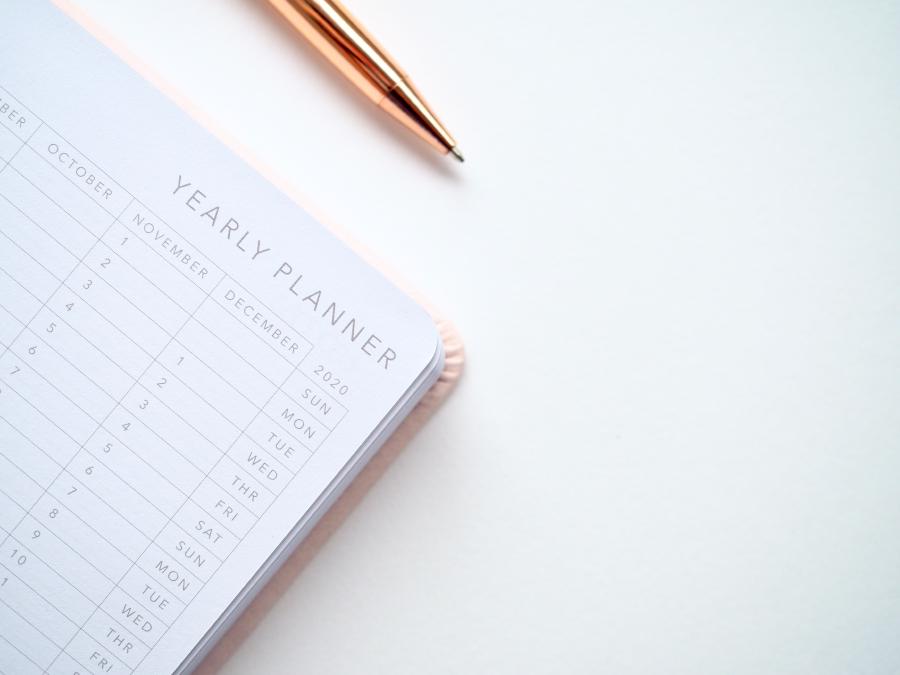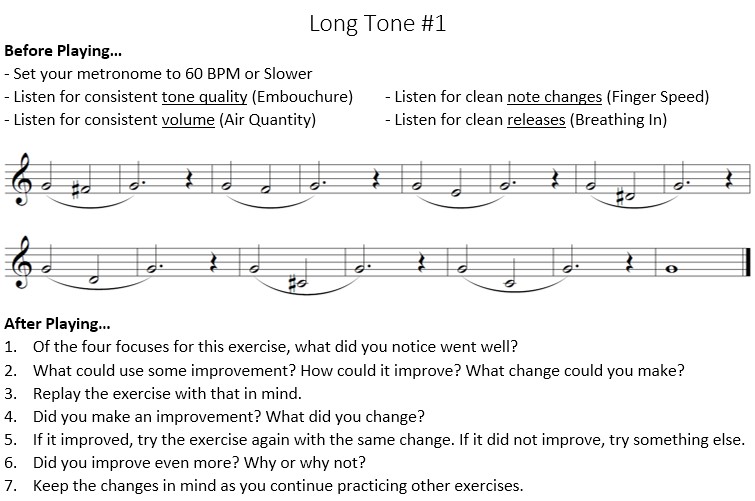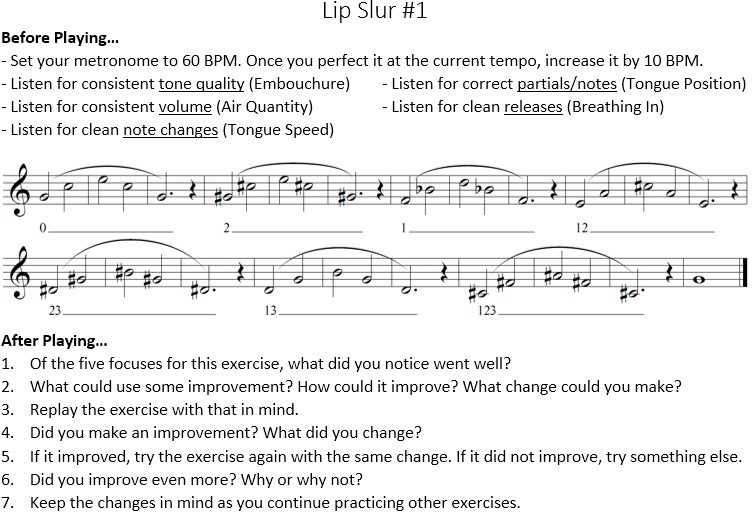
The development of a learner’s executive function may be the most important task for modern educations. Executive function refers to the high-level cognitive skills that humans use to manage their behaviors (Weill Institute for Neurosciences, 2020). This includes the ability to regulate learning - especially over long periods of time (like a project). Within the instrumental music classroom, learners are part of a perpetual project of trying to become a professional on their instrument.
To ensure that learners have the tools necessary to facilitate this level of consistent and long-term growth, educators need to implement strategies that develop learners’ executive function in addition to course content.
Strategies
The following three strategies are by no means the only ways to develop executive function, but they are strategies that I have found particularly helpful when teaching instrumental music.
Guide Their Thinking

In 21st century America, we want everything fast.
Hungry? Just go to through the drive through - or better yet, have our passenger mobile order for us while we drive to the restaurant.
Want to know where the name “Crisco” comes from? Just pull out your phone and asks Google.
It is important that educators avoid the trap of solving a learner’s problems for them. When they do, the learner is deprived of the chance to think critically for themselves. The key is to guide the learner to a solution by scaffolding their thinking through a series of questions and prompts, while still letting them discover the answer for themselves.
Learner: I sound bad!
Educator: It’s great that you recognize that your sound could be better. This means that you doing a great job of developing your ear as a musician! Let me help you think through what might be causing the problem. What is it about your sound that you don’t like or think is bad? Based on what you know about your instrument, what might be causing the issue and why?
While telling the learner how to fix the problem might take significantly less time, the educator is robbing the learner of the chance to use and develop their critical and flexible thinking skills. The result is sacrificing long-term success to get an immediate solution (which may be appropriate in certain circumstances).
As the learner begins to think critically about problems that they are having and self-assess on their own, they gain independence and ownership over their own learning and improvement (DiTullio, 2018). This independence will leads to more frequent and higher quality self-assessment, rather than solely relying on the educator to assess them.
Model Pacing

It is important to remember that the educators aren’t just content knowledge experts. They also have significantly more experience and knowledge about “the process” of learning than learners do. However, it is all too common for educators to let this slip away while explaining an assignment. They walk the learners through the process and assume that they will understand their intent; if something is left out, the learner will be able to fill in the gaps themselves.
Spoiler Alert: They won’t and it will generally lead to one of three outcomes:
- The learners learn/do something incorrectly and have to be retaught.
- The educator becomes frustrated when the learners don’t understand the instructions.
- The learners learn/do something incorrectly and have to be retaught, and the educator gets frustrated when the learners don’t understand the instructions.
Sound familiar?
When given a goal, executive function is what springs into action as the brain charts a course of sequential steps towards the desired result (ECRA Group, Inc., 2018). This goal could be anything: a two-page essay on Beethoven’s first symphony, a slideshow on the history of the trumpet, or playing a two-octave F major scale.
Learners with under-developed executive function skills won’t be able to envision the course to the desired result, so they become paralyzed by not even knowing where to begin. This is especially true when the goal or task is something entirely new to them, like playing an instrument. This leaves them with two options: skip all of the intermediate steps that lead to improvement (ultimately resulting in no progress), or shutting down entirely and doing nothing (also resulting in no progress).
Educators must find ways to help develop these skills by dividing larger tasks into smaller goals for the learners to work towards. The easiest way to achieve this is by framing assignments in the same way that learners should approach practice so that they can emulate the process in both situations.
Educator: Play this long tone exercise and listen for your tone quality.
How did you sound - what was good and what could improve? Alright, let’s try that again, but focus on the things you made note of.
Was it better this time? Why or why not? What did you change? Alright, let’s try it one more time just to make sure that sticks.
Was it even better? Why or why not? Let’s keep those thoughts in mind as we move on to the next exercise.
This exchange clearly defines a set of goals, or checkpoints, through the exercise to achieve the desired result. This supplies a model for exactly how the learners should practice. The more that this process is reinforced during with the educator, the more likely that the learners will emulate it in their own practice. As time goes on, the educator can slowly ween the learners off of the more prescriptive process and then ask them to apply it to other exercises.
Identify Their Frustration

If you think back to the last new skill you learned, I’m going to guess that you started by loving the process of learning. There was nowhere to go but up and the only goal was to learn as much as possible. As you continued to progress, you began to refine your goal to a more specific target. As you keep working, progress starts to slow, and you hit the dreaded plateau. You feel like you’ve peaked; no matter how hard you try you just can’t get to the next level. Frustration begins to take over and defeat becomes more common than success.
While this may have been a single moment for you, there are over 17% of learners in the United States that deal with a constant feeling of frustration and anxiety due to academic and social challenges (ECRA Group, Inc., 2011). Educators need to help learners recognize that when they are feeling frustrated it’s their emotions that are actually preventing them from making progress. Learners need access to healthy interventions to ensure continued success.
Educator: Hey guys, I feel like we are not really making improvements on this portion of the music right now. Does anyone else feel that way?
How does it make you feel to repeat this section of the music and not feel like it’s getting any better?
It is important that we understand how our body reacts when we become frustrated. It starts with a feeling of stagnation which can lead to boredom or frustration, and these emotions can actually cause you to perform worse. I feel like we are at that point right now - just spinning our wheels. So to ensure that we are still making progress, we are going to move on to something else for now, but we will come back and conquer this later.
The exchange above helps the learners become more aware of their emotions by letting them see that the educator is aware of their own emotions. By bringing their awareness to that emotion during particular situation, plateauing, learners can begin to associate the two feelings together. Then when they encounter it again, they will have a better way to cope with it rather than trying to force something that isn’t working. It also takes advantage of the moment to explain why the group should move on to something else and affirms that they are not simply giving up, but that they will come back at a later time with a better mindset.
Curricula
The techniques from above can be implemented at any stage of an instrumental music class but tend to work best during fundamentals. This is because learners all have the same or similar tasks, so the educator’s comments are more likely to apply to everyone. Also, fundamental exercises tend to focus on a single skill at a time. This means that there is less overall cognitive load for the learners which provides more space to develop their executive function skills. Over time, verbal guidance during fundamentals can be phased out and then shifted to tasks with higher cognitive load, such as music rehearsal.
- Provide each learner with a packet of fundamental exercises that will be used during class.
- Above each exercise, provide common prompts that guide the learner through the performance and the self-evaluation of the exercises.
- During class, introduce each exercise by following the prompts with as much fidelity as possible.
- As the learners become comfortable with the procedure, allow time to pair up and guide each other through the packet and prompts. Circulate and facilitate the discussions amongst the groups.
- Slowly reduce the frequency and detail of the verbal guidance given during fundamentals and shift ownership to the learners.
- Slowly shift modeling from low cognitive load tasks (fundamentals) to high cognitive load tasks (music).
Below is an example of exercises that might be seen in a brass learner’s fundamentals packet.



Measuring Growth
As with anything else, it is important to actively assess growth so that there is evidence that the learners’ executive function is actually improving. The following are a couple of methods that music educators can utilize to make this assessment. Keep in mind that in order to get an accurate measurement of growth, there needs to be a baseline before implementation.
Writing Prompt
Learners are asked to write about how often and how long they typically practice. Additionally, they are asked to reflect on their practice sessions and describe what they would typically do with as much detail as possible. When evaluating, look for the level of detail provided in addition to the overall thoughtfulness, effectiveness, and overall confidence of their reflection.
Classroom Observation
Learners are provided a checklist of desired traits for an effective rehearsal (having materials, set-up on time, starts and stops, engaged, improving and adjusting each repetition, etc.). During class, the educator evaluates learners based on the checklist. The educator takes note when a learner begins to exhibit a desired trait and how often they exhibit it.
Performance Assessment
Learners are provided a short musical excerpt and a set amount of time to prepare it. For younger learners, this could be a sight-reading exercise with 30 seconds to study before performing. For older learners, this could be a longer etude with a month to practice before performing. Learners receive a rubric for how the performance will be graded (most states have a standardized rubric that could be used as the rubric or as a starting point for your own rubric). While the learner studies and performs, pay close attention to their process (especially if it is a sight-reading example) and their score. If they have a long study time, consider asking the learner how they went about preparing the piece.
References
Center on Brain Injury Research and Training. (2010, June 17). School-Based Assessment of Executive Functions. BrainLine. https://www.brainline.org/article/school-based-assessment-executive-functions
Center on the Developing Child. (n.d.). Enhancing and Practicing Executive Function Skills with Children from Infancy to Adolescence. Harvard University. https://children.wi.gov/Documents/Harvard%20Parenting%20Resource.pdf
DiTullio, G. (2018, November 9). Helping Students Develop Executive Function Skills. Edutopia. https://www.edutopia.org/article/helping-students-develop-executive-function-skills
ECRA Group, Inc. (2011, August). Addressing Executive Function at the Secondary Level: In the Classroom and as an RTI Intervention [White paper]. ECRA Group, Inc. https://www.atlantapublicschools.us/cms/lib/GA01000924/Centricity/domain/8535/correspondence/White%20paper%20-%20Addressing%20executive%20education%20at%20the%20Secondary%20Level%2008.11_1.pdf
Graham, Dakeyan Cha’ Dre’. (2015, March 13). Secondary Band Participation and Executive Function [Doctoral dissertation, University of South Florida, Tampa, United States of America]. https://scholarcommons.usf.edu/cgi/viewcontent.cgi?article=6684&context=etd
Weill Institute for Neurosciences. (2020). Executive Functions. University of California San Francisco. https://memory.ucsf.edu/symptoms/executive-functions